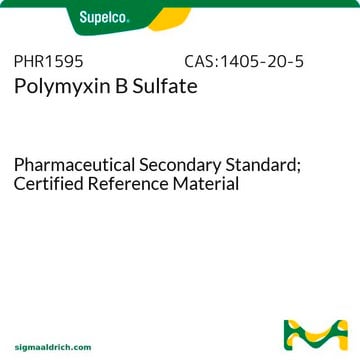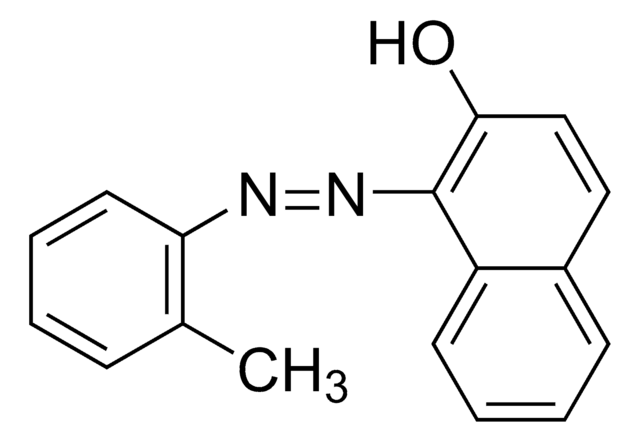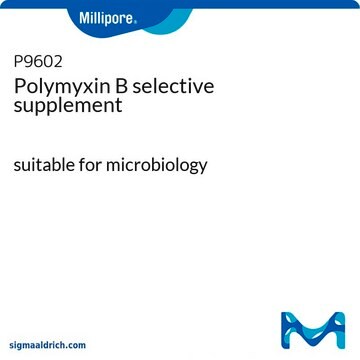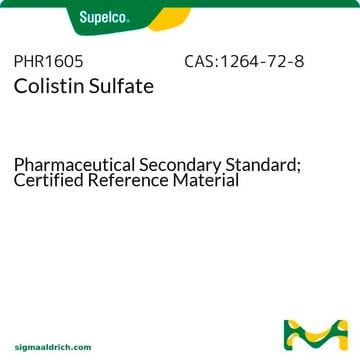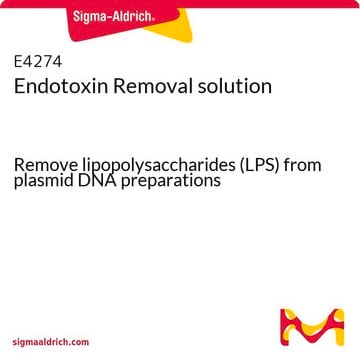81271
Polymyxin B solution
1 mg/mL in H2O, analytical standard
About This Item
Productos recomendados
grado
analytical standard
Nivel de calidad
concentración
1 mg/mL in H2O
técnicas
HPLC: suitable
gas chromatography (GC): suitable
espectro de actividad antibiótica
Gram-negative bacteria
Gram-positive bacteria
fungi
aplicaciones
pharmaceutical (small molecule)
formato
single component solution
Modo de acción
cell membrane | interferes
temp. de almacenamiento
2-8°C
InChI
1S/C48H82N16O13.H2O4S/c1-27(2)24-37-47(76)59-32(11-19-52)41(70)56-31(10-18-51)43(72)61-35(14-22-65)39(68)54-21-13-34(45(74)57-33(12-20-53)44(73)64-38(48(77)63-37)25-28-6-4-3-5-7-28)60-42(71)30(9-17-50)58-46(75)36(15-23-66)62-40(69)29(8-16-49)55-26-67;1-5(2,3)4/h3-7,26-27,29-38,65-66H,8-25,49-53H2,1-2H3,(H,54,68)(H,55,67)(H,56,70)(H,57,74)(H,58,75)(H,59,76)(H,60,71)(H,61,72)(H,62,69)(H,63,77)(H,64,73);(H2,1,2,3,4)
Clave InChI
HNDFYNOVSOOGDU-UHFFFAOYSA-N
¿Está buscando productos similares? Visita Guía de comparación de productos
Categorías relacionadas
Descripción general
Aplicación
Acciones bioquímicas o fisiológicas
Mode of Resistance: The activity of Polymyxin B sulfate is inhibited by iron(II), Co(II), Mn(II) and Magnesium ions. Polymyxin B may also be incompaitible with other microbial agents, including amphoterecin, cephalothin sodium, cephasolin sodium and heparin sodium.
Antimicrobial Spectrum: Has bactericidal action on most gram-negative bacilli, including E. Coli and on most fungi and gram-positive bacteria.
Nota de preparación
Código de clase de almacenamiento
12 - Non Combustible Liquids
Clase de riesgo para el agua (WGK)
WGK 2
Punto de inflamabilidad (°F)
Not applicable
Punto de inflamabilidad (°C)
Not applicable
Equipo de protección personal
Eyeshields, Faceshields, Gloves
Choose from one of the most recent versions:
¿Ya tiene este producto?
Encuentre la documentación para los productos que ha comprado recientemente en la Biblioteca de documentos.
Los clientes también vieron
Nuestro equipo de científicos tiene experiencia en todas las áreas de investigación: Ciencias de la vida, Ciencia de los materiales, Síntesis química, Cromatografía, Analítica y muchas otras.
Póngase en contacto con el Servicio técnico
